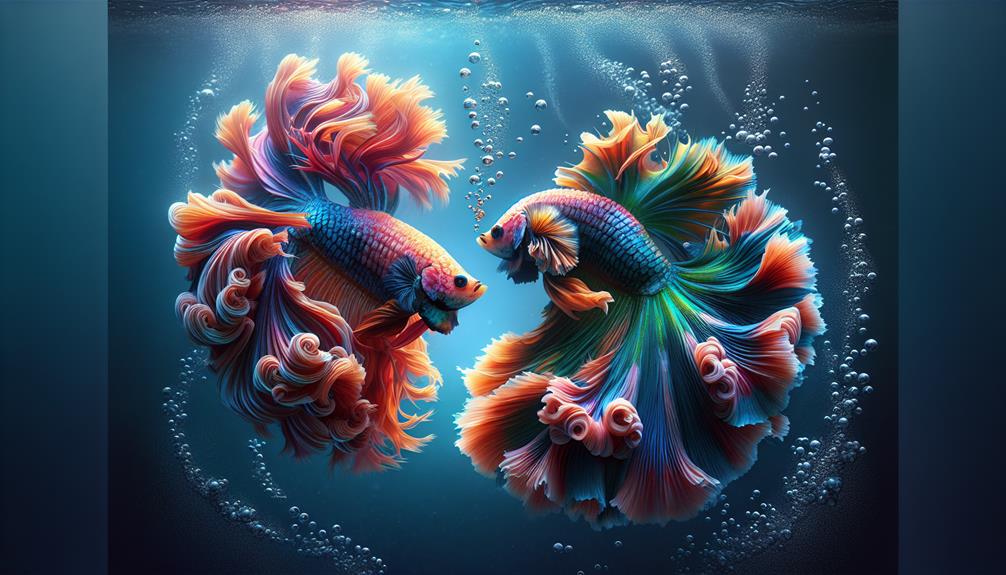Why Do Betta Fish Breed in Such Unique Ways?

Imagine a delicate dance where the male betta fish, resplendent in vibrant hues, creates a bubble nest at the water's surface. This seemingly intricate ritual is just one aspect of the fascinating world of betta fish breeding.
Have you ever wondered why these fish exhibit such unique behaviors when it comes to reproduction? Stay tuned to uncover the evolutionary adaptations, complex courtship rituals, and environmental factors that contribute to the enigmatic breeding practices of bettas.
Evolutionary Adaptations of Betta Fish Breeding
Evolved over millennia to survive in diverse environments, Betta fish showcase an array of remarkable adaptations in their breeding behaviors. One of the most striking features of Betta fish is their colorful displays during courtship. This vivid and varied coloration isn't just for aesthetic purposes but plays an important role in attracting potential mates. The genetic diversity among Betta fish populations contributes greatly to this wide range of colors and patterns, allowing for unique individuals to stand out and increase their chances of successful reproduction.
The genetic diversity in Betta fish populations is a result of their natural habitat and evolutionary history. Different environmental pressures have shaped the genetic makeup of Betta fish, leading to the vast array of colors seen today. This diversity not only enhances the visual appeal of these fish but also plays a crucial role in their survival and reproductive success. By showcasing such vibrant displays, Betta fish demonstrate how genetic diversity can drive adaptation and evolution in species over time.
Complex Courtship Rituals of Bettas
The courtship rituals of Betta fish are intricate displays of behavior that play a vital role in their reproductive success. Male Bettas exhibit vibrant and colorful displays to attract females, showcasing their genetic fitness. This phenomenon is driven by evolutionary pressures to secure mating opportunities. Territorial aggression is another key aspect of Betta courtship. Males fiercely defend their bubble nest territories from rival males to guarantee successful mating.
Bubble nest building is a hallmark behavior during courtship. Male Bettas meticulously construct bubble nests using air bubbles and saliva to house fertilized eggs, showcasing their parenting abilities. This behavior serves as a visual cue to females of the male's readiness to breed. Additionally, fin flaring is a display of dominance and courtship. Male Bettas flare their elaborate fins to appear larger and more attractive to females, establishing their superiority over competitors.
Understanding these complex courtship rituals provides insight into the fascinating breeding behaviors of Betta fish. The interplay of colorful displays, territorial aggression, bubble nest building, and fin flaring highlights the intricate strategies employed by Bettas to guarantee successful reproduction.
Anatomical Features Influencing Breeding Behavior
Male Betta fish possess distinct anatomical features that directly influence their breeding behavior, shaping the dynamics of courtship rituals and reproductive success. One key anatomical feature is the labyrinth organ, an accessory breathing structure that allows Betta fish to breathe atmospheric oxygen. During courtship, males build bubble nests at the water's surface using air bubbles. The labyrinth organ enables them to take in oxygen from the air, ensuring the survival of the developing eggs in the bubble nest.
Additionally, Betta fish have specialized fins that play a pivotal role in courtship displays. The long, flowing fins of male Bettas serve as visual cues to attract females during courtship. The vibrant colors and intricate patterns of their fins signal genetic fitness and health, influencing female mate choice and reproductive success.
These anatomical features are closely linked to hormonal regulation and behavioral responses in Betta fish. Hormones like testosterone play a significant role in shaping their aggressive behaviors and territorial tendencies during courtship. Understanding how these anatomical features interact with hormonal regulation provides valuable insights into the unique breeding behaviors of Betta fish.
Environmental Triggers for Betta Fish Spawning
What environmental factors trigger Betta fish spawning?
Betta fish are highly sensitive to their environment, and specific triggers play a critical role in initiating the spawning process. One key factor is temperature fluctuations. Betta fish are tropical species that thrive in warm waters between 75-80°F (24-27°C). To induce spawning, simulate the natural conditions of their native habitats by gradually raising the water temperature. This temperature change signals to the fish that the breeding season has arrived, prompting them to prepare for mating.
Another critical environmental factor is water quality. Clean, well-maintained water is essential for Betta fish to feel comfortable and safe enough to spawn. Poor water conditions can stress the fish and inhibit their natural breeding instincts. Ensure the tank is properly cycled, with stable parameters for ammonia, nitrites, and nitrates. Regular water changes and filtration maintenance are vital to provide a healthy environment conducive to spawning.
Parental Care in Betta Fish Reproduction
Parental care plays an important role in Betta fish reproduction, influencing the survival and development of their offspring. Maternal instincts are particularly strong in female Betta fish. After spawning, the female Betta fish takes on the primary responsibility of caring for the eggs. She carefully tends to the eggs, protecting them from threats and ensuring they receive adequate oxygen circulation.
The male Betta fish, on the other hand, plays vital paternal roles in the process. Once the eggs hatch, the male Betta fish takes an active role in guarding the fry, ensuring their safety and guiding them towards food sources. This division of labor between the male and female Betta fish showcases a unique form of parental care in the species.
The intricate behaviors displayed by both parents contribute greatly to the survival rates of the offspring, highlighting the evolutionary adaptations that have shaped Betta fish reproductive strategies.
Conclusion
To sum up, betta fish exhibit unique breeding behaviors as a result of evolutionary adaptations, complex courtship rituals, anatomical features, environmental triggers, and parental care.
These factors work together to guarantee successful reproduction and survival of their offspring.
Understanding the intricacies of betta fish breeding can provide valuable insights into the fascinating world of animal behavior and reproductive strategies in the aquatic domain.
